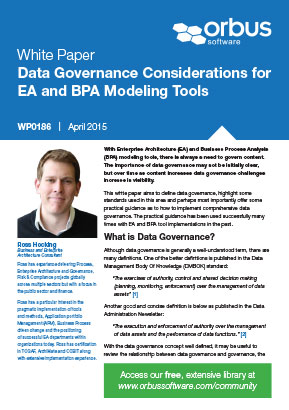This white paper aims to define data governance, highlight some standards used in this area and perhaps most importantly offer some practical guidance as to how to implement comprehensive data governance.
With Enterprise Architecture (EA) and Business Process Analysis (BPA) modeling tools, there is always a need to govern content. The importance of data governance may not be initially clear, but over time as content increases data governance challenges increase in visibility.
This white paper aims to define data governance, highlight some standards used in this area and perhaps most importantly offer some practical guidance as to how to implement comprehensive data governance. The practical guidance has been used successfully many times with EA and BPA tool implementations in the past.
What is Data Governance?
Although data governance is generally a well-understood term, there are many definitions. One of the better definitions is published in the Data Management Body Of Knowledge (DMBOK) standard:
“The exercises of authority, control and shared decision making (planning, monitoring, enforcement) over the management of data assets”
Another good and concise definition is below as published in the Data Administration Newsletter:
“The execution and enforcement of authority over the management of data assets and the performance of data functions.”
With the data governance concept well defined, it may be useful to review the relationship between data governance and governance, the latter is much broader and has a close relationship with government.
Login to continue reading or register now to download the ebook.
